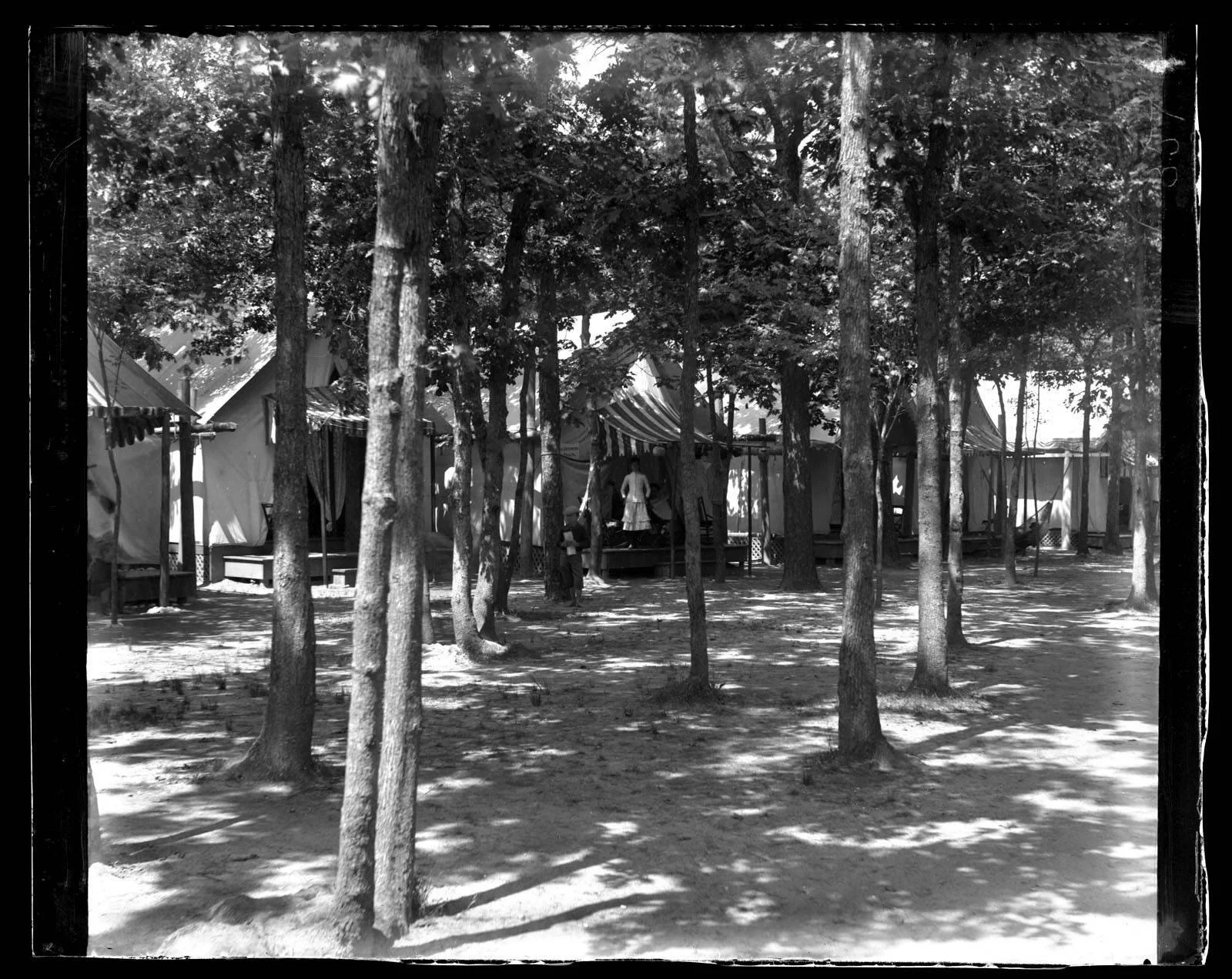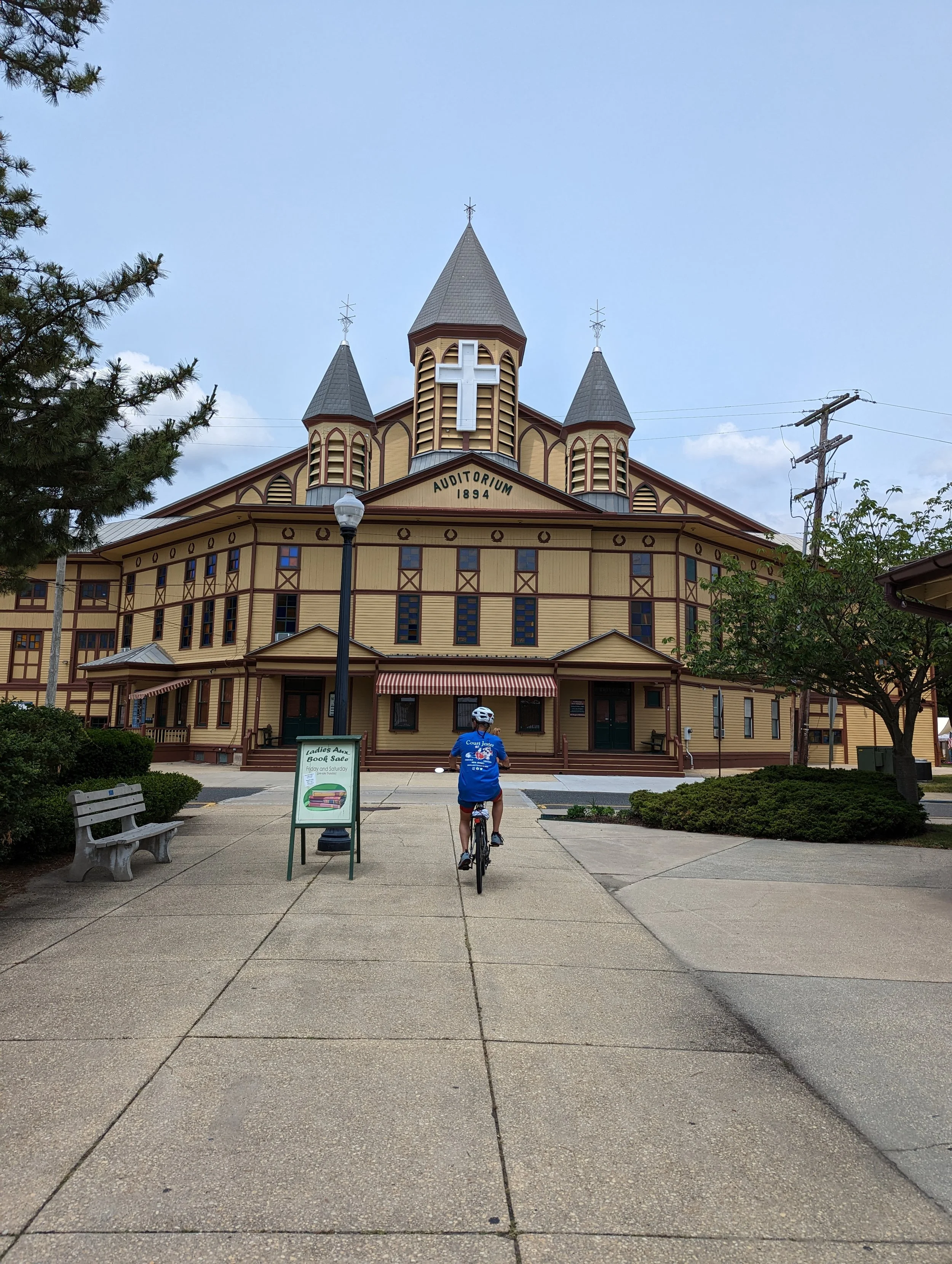A Sunday morning beach access dispute in the town of Ocean Grove, finds the leaders of the 154-year-old Ocean Grove Camp Meeting Association (OGCMA) once again defending their different perspectives on the management of their unique Methodist heritage community.
Ocean Grove in 1884 Marriott C. Morris Collection Library Company of Philadelphia
Opponents, particularly the local advocacy group Neptune United, want unfettered access to the beach from the boardwalk before noon on Sundays. The Camp Meeting purchased the beachfront in 1887, and want to continue their tradition of a few hours of quiet reflection on an empty beach. The NJDEP has apparently given notice that they are monitoring the situation for possible violations, and the Camp Meeting is in discussions with the state over their view of the law.
Groups and individuals have always looked for change here. The OGCMA owns all the land except the streets in town. The community programs and the public spaces reflect OGCMA’s mission of a Christian seaside setting. Their vision is “a community where all generations can know and grow in Jesus.” It has been this way from the beginning when President Rev. Elwood Stokes declared “God is here.” Neptune United and others have argued the Camp Meeting Association is insensitive to the secular majority. It is always hard to get the true pulse of actual homeowners, who seem to love their community. For readers looking for a more nuanced view of the modern beat of Ocean Grove, Blogfinger.net, is a good archive. The blog run by Dr. Paul Goldfinger, covers the town from many perspectives, current and past.
This is only the latest battle that belies the peaceful look of porch-life in Ocean Grove.
In 2022 the controversy was plans for the rebuilding of the Ocean Grove pier. The view from above forms the shape of a cross; a symbol some in the community are not comfortable with.
In 2007, the Camp Meeting was sued to permit two women to marry in a beachside pavilion after the state approved same-sex marriages. The courts ruled in favor of the individual’s civil rights.
In 1979, the town lost the right to close its gates to Sunday traffic after 108 years.
The longest-running battle was over a road. Oceanfront driving was a pastime enjoyed by those with horse and carriage, and the rides in Long Branch south past the Elberon mansions, or north to the Twin Lights were famous. In 1898 Bradley Beach bragged that they had completed an Ocean Boulevard the length of the town. A level, gravel road fronting the beach. They wanted a bridge over Fletcher Lake to the north and the Shark River to continue the road south to Sea Girt.
An Ocean Boulevard Committee was formed and Samuel Heilner and OH Brown of Spring Lake were enthusiastic leaders who echoed the sentiment for a coastal road all along Monmouth County. Touted as “One of the great drives in America”, they sought the support of all the area mayors and state representatives. There was one holdout. Ocean Grove did not want the road to connect their town to the others. The OGCMA knew that such a road could not be closed on Sunday. Asbury Park, Belmar, and Bradley Beach leaders were beside themselves. Without Ocean Grove, the drive would be ruined.
In 1901 an article titled “Battle Royale waged before Legislative Committee” appeared in the Shore Press “Every municipality on the Shore has passed resolutions asking that this arbitrary obstruction to one of the finest natural drives in the world be removed. There is no desire or wish on the part of these advocates of the boulevard to disturb any existing institutions; neither is there any necessity for such a disturbance. The effort of a few of the opponents of the measure to enlist the support of a religious denomination through such assertions is apparently, deliberately, and intentionally dishonest.
The pathway from the ocean to the 1894 Great Auditorium
As matters now stand 26 miles of seashore are held up by one crowd controlling about one-half mile of shore frontage and the public is compelled to depend for Intercourse between the two sections thus-kept apart upon one narrow congested street already preempted by a street railway with one track (and to accommodate the travel there ought to and soon must be two tracks)”
Ocean Grove was very clear. Rev. Dr. Arron E. Ballard and the other leaders did not want to bridge Wesley Lake or Fletcher Lake and subject their Sunday quiet and seaside worship to traffic. Others planned for their eventual capitulation.
In 1905 the Asbury Park Press reported, “Founder Bradley is building an ocean roadway around Deal Lake and will connect Asbury Park's roadway with Loch Arbour, thus affording a still greater convenience for carriages and automobiles…A continuous roadway to Loch Arbour should be the prelude of a continuous boulevard through Ocean Grove to Bradley Beach and thence to Belmar, thus fulfilling the dream of years, a 30-mlle Ocean Boulevard on the North Jersey coast.
The pathway and the original auditorium in 1884 Marriot C. Morris Library Company of Philadelphia
The Camp meeting was unmoved. They were not installing natural gas or the ocean road. A 1906 Perth Amboy Press noted, “The gas question and ocean boulevard agitation are occupying peaceful graves side by side In the cemetery where the Ocean Grove Camp Meeting Association has in years past laid away many other demands of the public.“
In 1907 at a Long Branch state convention of newspaper editors, the Asbury Park Press introduced a more radical concept. They wanted “…active support and championship In behalf of state aid for a grand ocean boulevard- to extend from Atlantic Highlands to Cape May.” They wanted newspaper support throughout the state.
In support, The Long Branch Daily Record wrote: “‘Ocean Grove Is in a worse condition today than when the gamblers who formerly held sway In Long Branch of whom the pious camp meeting of old professed such horror that they opposed an Ocean boulevard for fear that they would pollute the sacred precincts with their presence, were in control’, said an Ocean Grove pioneer to us today…”
“…Revolt is brewing at the religious resort. The property owners are it appears, becoming disgusted at the tyrannical management of Tyranny or oppression In the name of religion is no more pleasant than any other sort. The time Is ripe for a thorough airing of the affairs of the camp meeting association. If everything Is all right no one will be hurt.”
Dr. Ballard and the OGCMA were silent in response to the threats.
Governor John Franklin Fort in a meeting of Monmouth County property owners in 1908 indicated his support for the state to support, ”Building of a road over 125 miles in length, (from Atlantic Highlands to Cape May), which will, when completed rival those of Europe and cause many heretofore strangers to visit our coast and tour the already famous for its beautiful scenery and perfect roads. The new and diversified benefits which the people of the whole state will receive from an Ocean Boulevard would bring about its successful construction without opposition from any part of the state.”
Asbury Park kept up the heat on Sept. 25, 1908, STRAIGHT BOULEVARD OR NONE. “So far as Asbury Park Is concerned an ocean boulevard which goes around Ocean Grove is no more an ocean boulevard than the play of Hamlet would be with the character of Hamlet left out.”
In early 1909 State Senator OH Brown pushed the state to pass legislation for a great parkway to run the length of the state from Atlantic Highlands to Cape May. The road, they estimated would cost $400,000 but be paid for with the boom in new automobile registrations.
In 1910, Asbury Park argued that it would be inexcusable for a bypass at Ocean Grove, and the Governor in the last year of his administration should press the OGCMA to change their mind.
By 1916, the long-planned bridge over the Shark River connecting Avon-by-the-Sea and Belmar made the people of Asbury Park angrier at Dr. Ballard and Ocean Grove, for making itself a “Detriment to the Coast, and an impediment to much-desired progress.”
But World War I intervened and state support for the Ocean Boulevard paving and maintenance lost steam. By 1919, the Monmouth County mayors attempted to get funding from the county, hopeful that a solution to the Ocean Grove problem could be worked out. The OGCMA was reported to be open-minded. OGCMA President Dr. Ballard was 98 years old and near death. General Manager Frank Smith said, “Where there is a will there is a way”. But no progress was made.
The fight was opened on two fronts in the 1920s. The Monmouth state senators continued to revive the state taking responsibility for the road, while the local mayors pressured the county. Everyone pressured Ocean Grove. By 1925, windshield stickers were placed on cars in protest. The Long Branch Record reported,
“Everywhere along the Shore one sees upon the windshields of automobiles stickers bearing; the legend, "Open the Road Through Ocean Grove." This is an outcome of the movement that originated In Bradley Beach but which has a host of sympathizers not only among residents of other shore resorts but of the Innumerable army of motorists from everywhere whose cars are seen on the ocean boulevard which stretches from Long Branch to Manaaquan with Ocean Grove as the only break. The Ocean Grove association has taken notice of the concerted effort to violate the sanctity of that resort and has adopted as a watchword that made famous by the French at Verdun, "They Shall Not Pass." The association relies upon the strength of Its charter to preserve It from the encroachments of the worldly. The opposition Insists that charter or no charter, Ocean Grove can no longer be permitted to stand as a stumbling block In the way of present-day needs and the demands of traffic. Certainly, some steps must be taken to relieve the congestion now caused on Main Street by the diversion of traffic going In both directions from the boulevard at Asbury Park and Bradley Beach. Travel on that short section is now attended with delay.
By 1929, the state had revived efforts to build the Parkway along the Ocean. But the Great Depression followed and then WWII, and money again was not available until the congestion of state roads 1, 9 and 34 called for a link from the northern communities to the Shore, with continued service to Cape May. The final layout through Monmouth County was not agreed to until 1949, when it swung close to the shore resorts, but did not hug the ocean. The new Garden State Parkway did not officially open until 1954. By that time, nearly everyone had stopped bothering Ocean Grove about their oceanfront road, and even today, you must drive around Fletcher Lake and Wesley Lake onto Route 71 to travel from Asbury Park to Bradley Beach.
The charm is still there





